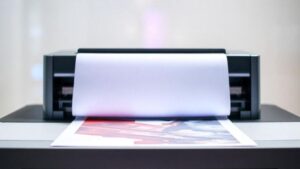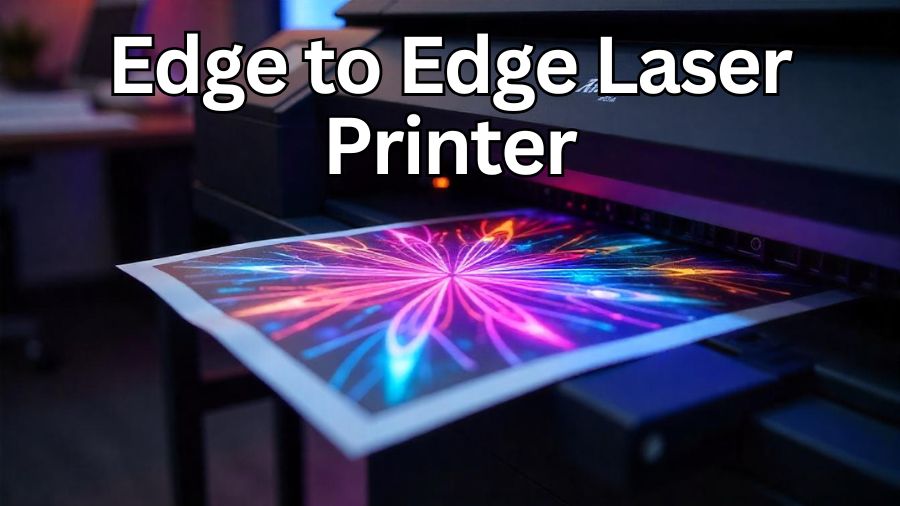Introduction to Edge-to-Edge Printing
Edge-to-edge printing, sometimes called “borderless printing,” means printing a picture or design that covers the entire page, leaving no white space around the edges. It’s a technique often used in printing photographs, brochures, posters, and other materials that need a polished, professional look. Having a full-coverage print helps make designs stand out and look more vivid on paper.
Most home and office printers add a small blank border around the edges of each print. This border is usually a few millimeters wide and is there to help prevent smudging or paper jams. However, some people want to print without this border to achieve a more professional look. This is where edge-to-edge printing becomes useful, especially for marketing materials or personal projects that need to look sharp and attractive.
Achieving borderless prints on a laser printer can be tricky because laser printers are not typically designed for edge-to-edge printing. While inkjet printers can often print to the edges of the paper, laser printers work differently. Laser printers use heat to bond toner (powdered ink) to the paper, and printing too close to the edge can lead to issues like smudges or even damage to the printer.
In this article, we’ll explore how edge-to-edge printing works with laser printers, the different methods to try to achieve it, and the challenges involved. This way, you can decide if edge-to-edge printing on a laser printer is the right option for your project or if another approach might work better.
How Laser Printers Handle Edge-to-Edge Printing
Laser printers have specific strengths, but they also have limitations when it comes to printing all the way to the edge of the paper. Most laser printers are designed to leave a small border around each print. This border is meant to help the printer run smoothly, prevent smudges, and avoid jams. Unlike inkjet printers, which can often print without borders, laser printers are less flexible for this purpose.
Laser printing works by bonding toner (a dry powder) to the paper using heat and pressure. When printing goes all the way to the edge, the toner can sometimes build up and cause clogs, smears, or even damage to the printer parts. This can make full-page printing risky, as it might harm the printer or lead to costly repairs.
For this reason, most laser printers cannot create a true edge-to-edge print. However, many people still want the clean, polished look that edge-to-edge printing offers. To achieve a similar effect with a laser printer, there are some workarounds, like printing on a larger sheet of paper and then trimming the edges. This way, the print can appear borderless without risking any harm to the printer.
Although edge-to-edge printing is a challenge for laser printers, understanding these limits can help you make better choices. If you know what’s possible and what’s not, you can plan your prints carefully. Whether you’re printing marketing materials or photos, knowing the basics of how laser printers work can help you get the best results.

Solutions for Edge-to-Edge Printing on Laser Printers
Achieving edge-to-edge prints on a laser printer isn’t always simple, but there are some tricks to get as close as possible. Here are a few methods that can help create a nearly borderless look without damaging the printer.
1. Print on Larger Paper and Trim One effective way to mimic edge-to-edge printing is by printing on paper that’s larger than the desired final size. For example, if you want an 8.5 x 11-inch borderless print, use a larger paper size, like 9 x 12 inches. Once printed, you can trim off the edges. This approach is often used by professionals who need high-quality, full-bleed prints. It avoids the risk of toner buildup on the edges and keeps the printer working smoothly.
2. Adjust Printer Settings Some laser printers have settings that can reduce the size of the border. By adjusting the page setup or margin settings, you might be able to print closer to the edge. While this won’t remove the border completely, it can make it smaller. Check your printer’s user manual or settings menu to see if there’s an option to shrink the default border.
3. Choose the Right Printer Not all laser printers are the same. Some models are better for edge-to-edge printing than others. High-end models or production printers, designed for commercial use, might offer smaller borders or special settings for near-borderless printing. When choosing a printer, look for options with “full-bleed” or “wide-format” features, as these often allow more flexible printing options.
These methods help get as close as possible to edge-to-edge printing on a laser printer. Although laser printers aren’t built for true borderless printing, using these solutions can give you a clean, professional look for your projects.
Alternative Options for Borderless Prints
While it can be challenging to get true edge-to-edge printing on a laser printer, there are other options that might work better, especially if you need frequent borderless prints. Here are some alternatives to consider.

1. Use an Inkjet Printer for Full-Bleed Printing If borderless printing is essential, an inkjet printer might be the best choice. Inkjet printers are often designed to print right to the edges of the paper. Many inkjet models come with a “borderless” setting that can handle this job with ease. They also work well for photo printing and can produce high-quality images. For projects like photo books, brochures, or posters, inkjet printers are a great option.
2. Choose a Printer with Wide-Format or Full-Bleed Features Some printers are made specifically for large-format or edge-to-edge printing. These models are often more expensive but can handle different paper sizes and full-bleed printing. They’re a good choice for businesses that need to print professional materials regularly. Look for printers that mention full-bleed, borderless, or wide-format capabilities in their specifications.
3. Consider Professional Printing Services For occasional projects that require flawless edge-to-edge prints, you might want to use a professional printing service. These services have high-quality printers that can handle full-bleed printing on a range of paper types. Local print shops or online services can print in large volumes and offer different sizes and finishes. This option saves you time and effort, especially if you only need borderless prints once in a while.
4. Explore Laser Printers with Near-Borderless Features Some high-end laser printers have settings that minimize the border. They might not be completely borderless but can print close to the edge. These printers are often used in businesses where print quality is important. If you need laser-quality prints with smaller borders, look for commercial models that support near-borderless printing.
Choosing the right tool for your printing needs can make a big difference in quality and efficiency. Whether you go with an inkjet, a special laser printer, or a professional service, you’ll be able to achieve high-quality, edge-to-edge prints for any project.
Step-by-Step Guide for Edge-to-Edge Printing
While laser printers aren’t usually built for edge-to-edge printing, you can still get as close as possible by following a few careful steps. Here’s a simple guide to help you set up your printer and paper for nearly borderless prints.

1. Use the Largest Paper Size Available One trick is to use a larger paper size than your final print size. For example, if you want an 8.5 x 11-inch print, try using 9 x 12-inch paper. Print your image on the larger paper, then trim the edges down to your desired size. This method allows you to avoid borders while protecting your printer from smudges or jams.
2. Adjust the Page Setup in Printer Settings In your printer settings, look for options to adjust the page layout or margins. Some printers allow you to set the margins to zero or as close to zero as possible. While it won’t fully remove the borders, this setting can help reduce them. Check your printer’s manual for guidance on changing these settings, as they can differ between models.
3. Use High-Quality Paper For edge-to-edge printing, choose thick, high-quality paper that can handle the heat and pressure of laser printing. Thicker paper reduces the chance of jams and smears near the edges. It also gives your prints a cleaner, more polished look, especially when trimmed.
4. Select the Right Media Type Some laser printers let you choose the “media type” before printing. This means you can select settings for thicker paper or special paper types. Choosing the right media type will help the printer apply toner evenly, which is important for clear, edge-to-edge prints.
5. Test Your Setup with a Sample Print Before starting a big project, print a test page to check the quality and make sure there are no issues near the edges. If you see smudges, try adjusting the paper size, layout, or media type. Testing will help you spot any problems before you start printing in large amounts.
Following these steps can help you get close to edge-to-edge printing on a laser printer. By adjusting settings and using larger paper sizes, you’ll achieve a clean, professional look without risking printer damage.
Common Issues and Solutions
Printing edge-to-edge on a laser printer can lead to a few challenges, but understanding these problems and knowing how to solve them can make a big difference. Here are some common issues you might face and ways to fix them.
1. Smudges or Toner Buildup When printing too close to the edge, laser printers can sometimes leave smudges. This happens because toner may build up on the edges, especially when there’s no white border. To fix this, use slightly larger paper than your final print size, then trim it down. This way, you get a clean print without toner buildup at the edges.
2. Paper Jams Laser printers may jam when printing edge-to-edge because toner near the edges can cause the paper to stick or wrinkle. To avoid this, select a thicker paper that can handle the printer’s heat and pressure. Choosing the right “media type” setting in your printer can also help prevent jams, as it adjusts the machine for different paper types.
3. Uneven Print Quality Near Edges Sometimes, prints look faded or uneven near the edges because laser printers aren’t designed to spread toner all the way across. Adjusting your printer’s layout or margins can help you get closer to the edge. However, if the quality near the edges is still uneven, try using a professional printing service for important projects that need full coverage.
4. Printer Overheating Laser printers use heat to set the toner on paper, and printing edge-to-edge can make the machine work harder, especially during large print jobs. Overheating can lead to errors or wear out the printer faster. To prevent this, let the printer cool down between large jobs, or consider using a professional printer service for big projects.
5. Toner Waste and Higher Costs Printing edge-to-edge can use more toner, which leads to more frequent cartridge replacements and higher costs. One way to reduce toner waste is by using larger paper and trimming to the right size. This way, you avoid reprinting due to quality issues, and you get clean prints without wasting toner on the edges.
Knowing these common issues and solutions can help you achieve better results with edge-to-edge printing on a laser printer. By handling these challenges with a few smart tricks, you can make the most of your laser printer while keeping it in good condition.
Conclusion
Printing edge-to-edge with a laser printer can be challenging, but it’s possible to get close with the right approach. Understanding the limits of laser printers helps in choosing the best method to achieve nearly borderless prints. While laser printers typically can’t do true edge-to-edge printing, using larger paper and trimming it down can create a similar effect. Adjusting the printer’s settings, like reducing margins or selecting the correct media type, can also improve print quality.
For projects that require perfect edge-to-edge printing, exploring alternatives like inkjet printers or professional printing services may be a good choice. Each option has its pros and cons, depending on your specific needs and budget.
In the end, choosing the right tools and methods can help you get clean, professional-looking prints without damaging your printer. Whether you’re printing photos, brochures, or other materials, a little planning can go a long way in creating beautiful, full-page prints that stand out.
Frequently Asked Questions (FAQ)
1. Can laser printers print edge-to-edge?
Most laser printers can’t print true edge-to-edge. They usually leave a small border for smooth operation and to prevent smudging or jamming.
2. How can I make my laser prints look borderless?
One way is to print on larger paper and then trim it to the size you want. This gives a borderless look without risking damage to your printer.
3. What’s the difference between edge-to-edge printing and borderless printing?
They mean the same thing—printing that covers the entire paper without any white border around the edges.
4. Are there laser printers made for edge-to-edge printing?
Some high-end laser printers have smaller borders, but they still don’t do true edge-to-edge. Inkjet printers are usually better for borderless printing.
5. Can adjusting settings help with edge-to-edge printing?
Yes, adjusting page setup and margins can reduce the border. It won’t completely remove it, but it can make the edges look closer to the print.
6. What type of paper is best for near-borderless laser printing?
Thicker, high-quality paper works best. It reduces the chance of jams and helps produce clearer, more even prints.
7. Will edge-to-edge printing damage my laser printer?
Printing too close to the edge can cause smudges or even damage parts of the printer. Using larger paper and trimming is safer for your printer.
8. Is professional printing a good option for edge-to-edge prints?
Yes, professional printing services are ideal for perfect borderless prints. They have printers designed for full-bleed printing and can handle large orders easily.
9. Does edge-to-edge printing use more toner?
Yes, it can use more toner, especially near the edges. This means you may need to replace toner cartridges more often if you print edge-to-edge regularly.
10. What’s the best alternative for borderless prints at home?
An inkjet printer with a borderless setting is a good choice for home printing if you need regular edge-to-edge prints.

